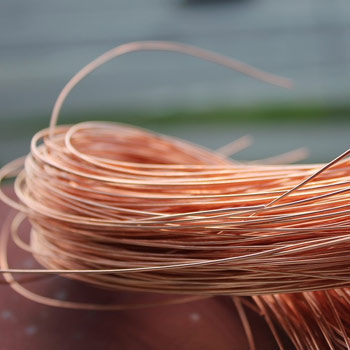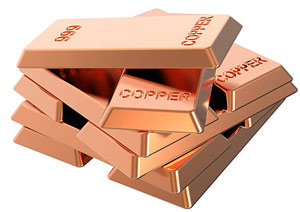
What should I know before investing in copper online?
Exchange copper refers to the buying and selling of copper futures contracts, which are traded on the world's major exchanges, such as the London Metal Exchange (LME), the New York Mercantile Exchange (NYMEX) and the Shanghai Futures Exchange (SHFE).
There are different types of exchange-traded copper, including cathode copper, blister copper and refined copper. Cathode copper is the most common type of copper traded on the exchange, as it is easily transportable and storable.
In the following section, we will look in detail at the different methods of buying copper on the exchange, as well as the financial products for investing in copper.
How can I invest in copper on the stock market?
There are several ways to buy copper on the stock exchange. Investors can buy copper futures, which are agreements to buy or sell copper at a specific price and date. They can also buy copper options, which give them the right to buy or sell copper at a specific price on a specific date.
Investors can also invest in exchange-traded funds (ETFs) that track copper prices. ETFs are index funds that are traded on an exchange like stocks and allow investors to buy exposure to the copper market without actually buying copper.
Each of these methods of buying copper on the exchange has advantages and disadvantages. Buying copper futures can be risky, as the price of copper can fluctuate rapidly and unpredictably. Buying copper options can also be risky, as the option price can fluctuate with market volatility.
Trading copper!{etoroCFDrisk}% of retail CFD accounts lose money - etoro.com
How do I invest in copper on the stock market with other instruments?
Investing in copper on the stock exchange can be done in a number of ways. In addition to ETFs, investors can invest in specialised commodity investment funds, which may include exposure to copper.
Investors can also buy shares in copper mining companies, which are companies that mine, produce and sell copper. However, investing in individual stocks can be risky, as the share price can be influenced by factors such as the company's financial performance or global economic and political conditions.
Ultimately, the choice of how to invest in copper on the stock market depends on the investor's investment objectives, their level of tolerable risk and their level of knowledge of the commodity market. Investors should take the time to evaluate the various options and consult with investment professionals to make an informed decision.
Financial products for investing in copper on the stock market include contracts for difference (CFDs). CFDs allow investors to speculate on the rise or fall of the price of copper without actually buying the metal.
How can I trade copper on the stock market with CFDs or contracts for difference?
It is also possible to invest in copper on the stock market using CFDs or contracts for difference. How CFDs work: the investor opens a position to buy or sell the price of copper, and closes it when the position reaches the desired level of profit or loss.
However, CFDs carry significant risks. Firstly, leverage can magnify losses as well as gains, and it can be quick to lose all your capital. In addition, CFDs are complex derivative products, requiring extensive market knowledge and trading experience.
It is therefore advisable to learn about CFD trading before you start, and not to invest more than you can afford to lose. CFDs are for experienced and knowledgeable investors only.
Trading copper!{etoroCFDrisk}% of retail CFD accounts lose money - etoro.com
How do I analyse the price of copper on the stock market before investing?
Before investing in copper on the stock market, it is important to analyse the metal's price and identify market trends. Here are some factors to bear in mind when analysing the price of copper on the stock market:
- Supply and demand: As with any commodity, supply and demand are the major factors influencing the price of copper on the stock market. It is therefore important to follow market trends and monitor economic indicators likely to affect supply and demand, such as mine production data, construction industry figures and the global economic outlook.
- Global economic growth: Copper is widely used in construction, the automotive industry, electronics and other sectors, making it an important economic indicator. Robust global economic growth can boost demand for copper, which in turn can support prices.
- Geopolitical factors: Geopolitical events can also have a significant impact on the price of copper on the stock market. For example, social or political conflicts in copper-producing countries can disrupt the production and export of this metal, which can influence prices.
- Supply conditions: Fluctuations in copper supply can result from a variety of factors, such as production levels in major producing countries such as Chile and Peru, production disruptions due to social unrest or natural disasters, and government mining and export policies.
- Technical analysis: Technical analysis involves studying charts and trends in the price of copper on the stock market in an attempt to predict future trends. Investors can use indicators such as moving averages, Bollinger bands and support and resistance levels to analyse the price of copper on the stock market.
- Changes in the US dollar: As copper is quoted in US dollars, fluctuations in the exchange rate between the dollar and other currencies can have an impact on its price. A fall in the dollar against other currencies can make copper cheaper for buyers in these regions, boosting demand and prices.
- Speculation on financial markets: Financial investors can also influence copper prices through speculative transactions on futures markets. Expectations of future supply and demand, as well as overall macroeconomic conditions, can lead to significant short-term price movements.
- Policy and regulation: Decisions by governments and regulators on trade policies, taxes, import duties, mining subsidies and environmental standards can all have an impact on the production and distribution of copper, and therefore on its price.
- Expert analysis: Finally, it is advisable to follow the analysis of copper market experts on the stock exchange, which can provide valuable information on current and future market trends.
In short, before investing in copper on the stock exchange, it is important to analyse economic and geopolitical factors, use technical analysis and follow expert analysis to identify market trends and make informed investment decisions.
Conclusion: How to invest in copper on the stock market?
In summary, there are several ways to buy and invest in copper on the stock market, such as futures contracts, ETFs or mining company shares.
Before buying or selling copper, it is important to carefully analyse market trends and to regularly monitor the price of copper on the stock exchange. The decision to invest in copper on the stock exchange should be carefully considered for each investor profile.
Ultimately, investing in copper on the stock exchange requires a good knowledge of this commodity and its market and must be done with caution and taking into account all relevant factors to avoid financial losses.


